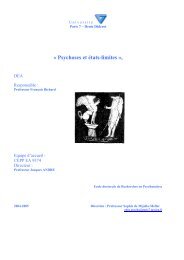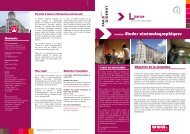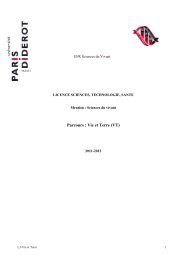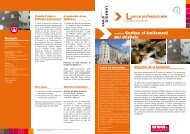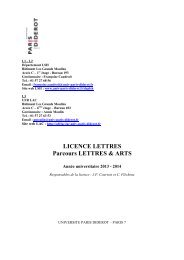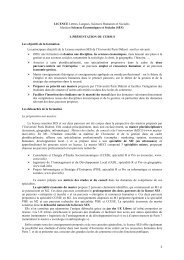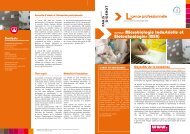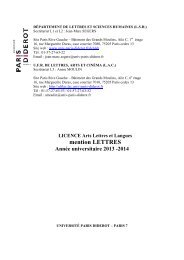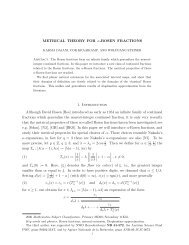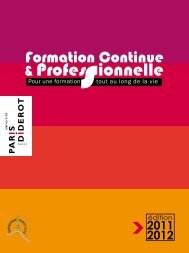Coordinator's names Carole DELPORTE-GALLET Hugues ...
Coordinator's names Carole DELPORTE-GALLET Hugues ...
Coordinator's names Carole DELPORTE-GALLET Hugues ...
Create successful ePaper yourself
Turn your PDF publications into a flip-book with our unique Google optimized e-Paper software.
Due to the impossibility result of FLP, oracles play a fundamental role concerning fault tolerance: as<br />
consensus is not possible in asynchronous models even with only one faulty process, in a very similar way<br />
to classical computability, it is natural to add oracles. Among other things, these oracles enable to establish<br />
hierarchies between (impossible) problems in distributed fault-tolerant computing. In this way, failure detectors<br />
are distributed oracles giving processes information about failures. The formal definition of failure<br />
detectors ensures that these oracles depend only on the failures and hence failure detectors encapsulate information<br />
about process crashes needed to solve the problem. One important point is that failure detectors<br />
may be compared by reduction: failure detector f is stronger than failure detector g if there is a distributed<br />
algorithm (a reduction) that enables to output g from f. In this way, failure detectors may be used to<br />
compare the difficulty of problems and enable to establish hierarchy between problems that are impossible<br />
to solve with process crashes.<br />
Another kind of oracles appears also in wait-free computations. Atomic objects like “test&set”, “cmp&swap”<br />
are not wait-free implementable in read-write restricted shared memory. In this way, calls to these objects<br />
may be considered as calls to oracles. Here, contrary to failure detectors that depend only on failures, the<br />
calls of these atomic objects depend also on the specification of the object. One of the main results about<br />
wait-free computation is the Herlihy’s consensus number [22] that enables to define a hierarchy between<br />
computational power of atomic objects.<br />
An important tool in wait-free computation is the BG simulation [4, 5] that enables to simulate systems<br />
t-resilient of n processes with systems of wait-free t + 1 processes. A very important question is how that<br />
kind of simulation may be extended to systems with oracles like failure detectors.<br />
More recently, another approach has been proposed([12]). Instead of having an oracle that gives information<br />
about failures, it is possible to consider that an adversary may choose which sets of processes are<br />
correct. For example, if we know that only processes a, b, c or a, b or a, c may be the processes that do not<br />
crash (the adversary may only choose one of these three sets) it is possible to have an algorithm solving<br />
consensus (intuitively a being correct in all the cases, a may realize the consensus). It is then possible to<br />
determine for a given problem some structural properties on the set of sets of correct processes that enable<br />
to solve this problem. For example, for the k-set agreement task the set of sets of correct processes for<br />
which there is a solution roughly corresponds to set of sets of corrects processes having at least k + 1 correct<br />
processes. A very interesting point is to study the relationship between failure detectors and the adversaries.<br />
In particular one of the main result concerning failure detectors, define the minimum failure detector to solve<br />
the k-set agreement, may be obtained by considering adversaries that enable to solve the k-set agreement.<br />
Concerning the more “network computing” oriented approach, oracles are also interesting. Some very<br />
simple oracles may also change the possibility and impossibility results. For example in an anonymous ring<br />
of processus, an oracle giving the number of nodes enables to separate rings of different sizes. More generally,<br />
the notion of oracles in this context may be an important tool concerning complexity issues.<br />
From a more practical point of view, many problems in distributed computing lead to graph representations<br />
where oracles may have an important role. For example, a peer to peer system is a graph, representing<br />
the topology of the logical network. Many relationships between entities can be represented by an edge in a<br />
graph: for instance a social network can be represented by a graph where there is an edge between 2 users<br />
if they are friends on Facebook, or an edge could be present between an item and a node if the node has<br />
used or tagged or bought an item (for example recommenders systems rely on such graphs). There are two<br />
main classes of problems that emerge: (i) either a graph exists and the goal is to extract some information<br />
from the graph that can then be used to provide a given functionnality in a distributed system (this includes<br />
studying the graph properteis of a social graph for example), or (ii) a graph is created to achieve some<br />
functionality of a system and its properties may help to tune the system (for example creation of a given<br />
overlay and study the properties of the resulting graph). This is typically some problems that should concern<br />
both communities.<br />
Objectives of the task:<br />
Sub-Task 3.1: Define a general theory of oracles in distributed computation is a preliminary goal of this<br />
task. For this the notion of reduction between oracles is central. The extension of usual reductions<br />
10




